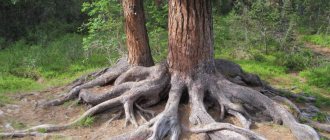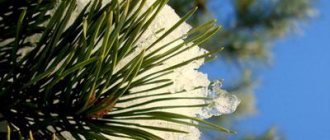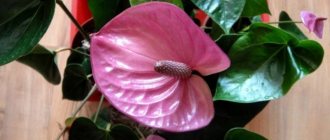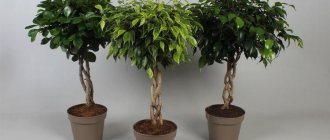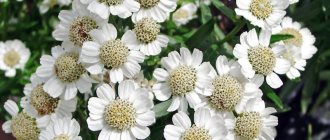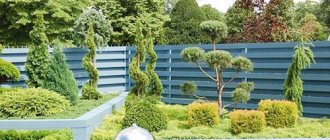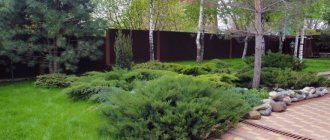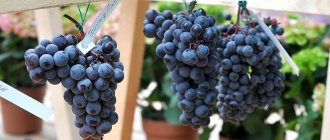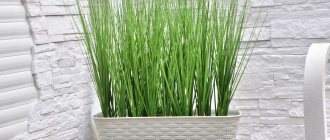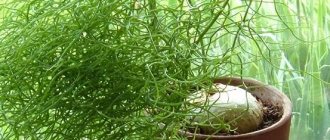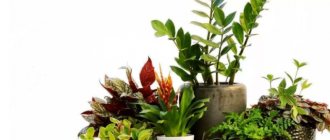One day, without any “malicious intent,” I was patrolling the market, it’s very fashionable now to name stores, I haven’t seen the names that I’ve gotten used to since childhood for a long time, and so I wandered around this eatery to get something for tea. Having put various drugs in a bag, “I was already steering” to the cash register, when suddenly, approaching the place of payment, I saw on the shelf near the cash register that there was either a tree or a bush, which very much reminded me in a reduced size of the “tree” that grows at my uncle’s dacha. I looked. the name, which said that this was a kind of mix, and a coniferous one, and this mix was produced not just anywhere, but in Holland itself, a massive exporter of tulips to Russia, thought, “Since tulips are in great demand here, why not experiment with conifers, and why did you take it, maybe this beauty will also be cozy in the house. So I brought the pot into a house with a normal climate, after which I began to ask the Internet what to do with it and how to live together, and this is what I managed to “dig up” That’s what I’m sharing with you, friends, maybe someone also has such a miracle at home or on their property...
I bought this miniature..., perhaps, I'm tired of making a "bonsai" out of it... Several years ago, the whole country was swept by a coniferous boom. Gardening stores and supermarket shelves were filled with inexpensive pots with coniferous plants of all colors and sizes. Imported Dutch seedlings, as a rule, were without labels and went under one name - “coniferous mixes”. Of course, everyone knows that the word “mix” is translated as “mixture.” Gardening enthusiasts have an excellent opportunity to purchase several representatives of the conifer family at a low price. It is not particularly difficult to grow a coniferous mix. Care, of course, is required, but the result is worth it. Thujas, fir trees, cypresses and junipers began to appear here and there in home gardens. But after a couple of years, the already grown trees upset their owners with rags of red, dead crowns. The thing is that at that time the coniferous mixes mainly consisted of capricious and heat-loving Lawson cypresses. Unfortunately, in our latitudes these plants suffered from both winter frosts and spring sun. And it’s a pity, because among them one could find real masterpieces. These are the Silver Queen cypress with beautiful silver-white shoots, and the same Ivonne Lawson with amazing lemon-yellow branches. HOW TO CARE FOR CYPRESS But don’t get upset and exclude these plants from your garden. Only the columnar form will have to be abandoned; cypress trees will be grown as ground cover. But it will be possible to create completely new compositions. To do this, very young plants are taken. After planting, you need to bend all the branches from the center to the sides and fix them with spears. You can use other devices, it is important that one plant should resemble a spider. And as the shoots grow, you should rearrange the spears. This is done twice a day. year. In the spring, as soon as the snow melts, and at the end of summer, so that the cypress tree “remembers” its new shape before the cold weather. After a few years, its branches will take root. With this type of cultivation, preparing the plant for winter is very simple - just cover it with spruce branches (2 layers). imagination and combine pruning with bending of branches. In addition to cypress trees, other conifers can be grown in this way: these are pines, arborvitae, and spruce. HOW TO CARE FOR JUNIPER For juniper, you need to choose a planting site that is ventilated, sunny, with moist, light soil. A pit for. t of frost, and in summer it will protect against loss of moisture. And, importantly, the soil in the pit will remain loose. ============================================ Everyone knows that all coniferous mixes, including juniper, are susceptible to burning. Therefore, in summer they need to be shaded, and spruce branches or lutrasil are used to protect them from the bright spring sun. In early spring, dry branches should be removed and the plant should be given the required shape. Creeping species are pruned in summer. And bonsai are trimmed twice a year - April and October. As you can see, no special knowledge or effort is required to grow coniferous plants. So feel free to buy a coniferous mix and start growing it. - source of GOOD LUCK IN YOUR EXPERIMENTS, FRIENDS, WITH CONIFERS! By the way, I saw at the market that they also sell blue spruce trees, so don’t bother waiting for the blue beauties to sprout their seeds...
Source: www.liveinternet.ru
The conifer family (conifer ales) includes pine, spruce, fir, larch, cedar, as well as shrubs: juniper, thuja, yew, hemlock, cypress. These plant species have taken root well in our central Russia. An ensemble of coniferous trees and shrubs is widely used by landscape designers, creating fabulous landscapes and landscapes.
What are the benefits of coniferous plants? The fact that throughout the year coniferous trees and shrubs delight with their beauty and make the air clean because... They secrete phytoncides that kill pathogenic microbes and even some insects and fill the air with the tart smell of resin. Their fallen needles serve as a fertile layer for plant roots.
Until recently, conifers were considered unsuitable for growing indoors. Now several cypress trees
cultivated as indoor plants. They all grow slowly and sometimes require root pruning in early spring to curb growth. Caring for conifers is simple. It is better to place them in group compositions as a background for more colorful plants.
The most beautiful and famous among amateur gardeners for its erect stem
Goldcrest
cypress , and the weeping form
of the Kashmir cypress
(
c. cashmeriana
).
Care requirements.
For conifers, it is very important that the earth ball around the roots is preserved, because
Symbiont fungi live on the roots and help absorb nutrients from the soil. For growing ornamental coniferous plants at home, there are special “Kiparisovik” soils on sale, where the soil composition is already prepared and balanced. Secrets of care.
The soil
: mix 3 parts of leaf, 3 parts of humus, 3 parts of clay-turf and 1 part of coarse sand or its substitute (expanded clay).
Lighting
: bright, diffused light.
Watering
: abundant from spring to autumn, moderate in winter.
Air humidity
: It is useful to spray with water from time to time.
Replanting
: once every 2 years in the spring.
Temperature
: in winter not lower than +8C.
Source: www.myjane.ru
Growing indoor coniferous tree large-fruited cypress
Large-fruited cypress is a slender tree with a thin trunk and feathery horizontal tetrahedral branches that can decorate the interior of an apartment, office, hall and winter garden. The scale-like greens of cypress, like pine needles, have the same fresh aroma.
By its nature, the coniferous cypress tree is not a houseplant, but with proper care it can grow successfully for many years. The main difficulty is keeping it in the room during the winter. Plants do not tolerate high temperatures and dry air. To grow this coniferous tree at home, it needs a lot of light, air and a cool room. This is ideal. But in practice, good results are obtained when keeping cypress in winter on sunny windows with ventilation from the window.
The cypress must be kept here until March; when young, blossoming buds begin to turn yellow from bright sunlight, the plants are moved to other windows or slightly shaded. From the scattered light, the buds bloom together.
If the plants were in the room in the spring, it is not recommended to expose them to the air in the summer. In the fall, when brought into a room, they immediately lose their needles.
This does not apply to plants kept in winter at a temperature of +6...+10°C in cool rooms or in winter gardens. In summer they can be displayed on balconies, gardens or terraces, provided they are protected from direct sunlight.
When caring for this coniferous plant at home, do not forget that cypress is very moisture-loving. Therefore, watering becomes essential, especially in summer. In autumn and winter, watering is reduced, but the lump of earth should not dry out. You need to be especially careful about watering in winter, when heating quickly dries out the soil in flower pots.
Water for irrigation needs to be settled and at room temperature. Daily spraying (morning and evening) with cool water is very useful.
Plants should be replanted when young shoots appear. The container is larger in diameter and height than the previous one by only 1.5-2.0 cm. In general, cypress does not like large pots. The soil for replanting is prepared as clay-turf with the addition of leaf, coniferous and coarse sand. When growing this coniferous plant at home, it is necessary to ensure good drainage. Since specialized stores have a large selection of soil mixtures, including those for conifers, it is better to purchase it there.
When replanting plants, you must keep in mind that they do not tolerate being buried. The root collar should be level with the soil surface.
Once or twice a month, it is advisable to feed with special mineral fertilizers for coniferous plants, but in low concentration.
Cypress is not damaged by pests with the exception of spider mites, which appear in dry air and high room temperatures.
The propagation of these coniferous plants at home is carried out in the same way as the propagation of araucaria.
Good to know:
- Most dwarf cypress trees have a strict symmetrical shape. Therefore, they are especially suitable for alpine slides, which are based on symmetry.
- Cypress trees need soil containing calcium.
How to propagate the coniferous houseplant Araucaria excelsa at home (with photo)
Araucaria excelsa (noble) is native to South Africa and Australia. A beautiful tree up to 1.5-2 m in height, with a regular tiered arrangement of whorled branches. The needles of this plant are linear-subulate, imbricated. In the Compact form, it is a light green, bright color. On the contrary, the “Bidwilli” form has dark needles with a bluish tint.
There are three ways to propagate this coniferous plant at home: seeds, cuttings and layering. When the branches are layered, shoots appear from the axillary buds. The tops of the shoots are the best cutting material. Cuttings from the mother plant are taken only from vertically growing shoots. The lateral ones do not produce apical growth, but only horizontal growth.
To propagate these coniferous plants at home, cuttings are cut at the end of August, when the shoots begin to become lignified. For rooting, they are planted in small pots (7 cm in diameter) with clean, washed, coarse sand.
In January - February, cuttings that have formed callus are transplanted into new pots, 9 cm in diameter, adding heather or leaf soil. Good drainage is required. The temperature of the newly planted plants is +20…+25°.
In June, the plants are taken out (dropped in) into open ground. Shade from the sun's rays and regular watering are required. In September, they are transferred to 12 cm pots and placed in a bright, cool room (+8...+10°).
In the seed propagation method, only freshly ripened seeds are used. After 2 weeks after collection, they may lose their germination capacity. To grow these coniferous plants at home, the oblong-shaped seeds are placed one end to half in a pot (5-7 cm) filled with leaf soil in half with sand and pieces of charcoal. The top of the sowing is covered with damp moss.
In winter, keep it in a cool room at a temperature of +5...+7°C with very limited watering, but not allowing the coma to dry out.
Despite the coolness, the plant needs light, not direct, but quite intense. In summer, araucaria should be taken out into the air in partial shade.
Araucaria is rejuvenated in a very unique way, at the age of 6-7 years. The upper part of the trunk is placed in a pot with light soil, after making a shallow cut around the circumference of the trunk. After rooting, the top is carefully trimmed, obtaining a young plant of the desired height. New shoots appear from the hemp remaining on the mother plant. Their tops can be used for cuttings.
Look at the photo on how to propagate the coniferous houseplant Araucaria excelsa at home:
How to grow the coniferous tree Araucaria varifolia at home
Variegated araucaria (tall) often comes to us as an import from Scandinavia.
Its homeland is Brazil, the islands of New Caledonia, where entire thickets of various types of araucaria form light, transparent forests. Araucaria was brought to Europe after the expedition of the legendary Captain Cook.
As you can see in the photo, this coniferous houseplant is a small tree up to 1 m high, reminiscent of an artificial New Year tree with the correct arrangement of tiers of whorls:
The needles are light green, the trunk is erect.
In summer, the plant needs bright, but not direct light and a well-ventilated room. In the spring and summer - abundant and frequent watering, but without stagnation of water in the pan. Stagnation of water is the reason for the death of roots, yellowing of needles and drooping branches, which are not restored later even when the water regime is normalized.
This plant benefits from fertilizing with low concentration complete mineral fertilizer (the dose of the drug indicated in the instructions is halved). The feeding interval is 2-3 weeks.
When caring for these coniferous plants at home with a constant summer temperature established, it is better to take the araucaria out into the air, shading it from direct sun. In hot weather, dry air is detrimental to the plant, so frequent spraying with water is required. During the growth process, the plant must be constantly rotated around its axis for uniform development of the crown.
In winter, this type of araucaria, like the previous one, is also kept in a cool but bright room. Ideal - in a winter garden or on a warm terrace.
In favorable indoor conditions, araucaria produces an increase of 2-3 tiers of branches.
Young plants are replanted annually, and adults - once every 3 years. The transplant must be essentially a transshipment, i.e. while maintaining a clod of earth, which helps prevent damage to the roots.
During transshipment, the substrate must be air- and water-permeable. The most suitable is a mixture of turf soil, leaf, coniferous soil, humus and sand in the following ratio 2:2:1:1:1 or turf soil, peat and sand in the ratio 4:2:1. A container for araucaria needs to have good drainage. When planting, it is important not to bury the root collar, otherwise the plant may die.
This coniferous tree propagates at home in the same way as the previous species, by cuttings and seeds. The technology for sowing seeds and propagating by cuttings is described in detail above.
Araucaria is valuable because it is almost not affected by diseases and pests. In exceptional cases, thrips may appear in dry air, and scale insects may appear in drafts.
Source: babushkinadacha.ru
Subtleties of caring for conifers at home
- Good lighting is not required. On the contrary, it is better if pots with coniferous indoor plants are located near a window facing north or northeast.
- Conifers are very sensitive to soil moisture. In summer, watering should be daily. In winter, they do not water every day, but in no case do they allow the soil to dry out. At the same time, there should not be excess water either.
- Air humidity is a necessary condition for the well-being of domestic coniferous plants. In summer, spraying is carried out every day, in winter less often, but from time to time they practice moistening the needles.
- Regular soil is not suitable for seedlings or flowers. It should be light and nutritious, but not too much. Usually the composition includes several parts - leaf soil, heather (or coniferous soil), coarse sand. It is difficult to make such a mixture yourself, so it is better to purchase a ready-made substrate “For conifers”.
- The optimal temperature at which plants feel good is from 6 to 10 °C. It is very difficult to create such conditions in an ordinary apartment.
Caring for coniferous indoor plants in winter
It is especially difficult for plants to tolerate living conditions in an ordinary apartment in winter. They need coolness, and at this time the radiators are turned on, the air in the room is dry, and the temperature is high. It is difficult to create ideal conditions for indoor coniferous plants, but you can at least try to make them optimal.
Where will the ephedra feel best? This could be a cold window on the north or northeast side, a glazed veranda or loggia. The air temperature should not fall below zero. Under no circumstances should the soil be allowed to freeze. Although conifers are resistant to low temperatures, freezing of the roots in a small pot is unacceptable; they die immediately. In winter, coniferous plants are dormant, so feeding is not required during this period. Watering should be moderate.
Caring for coniferous indoor plants in winter
Spraying should be daily. Once a month it is advisable to feed with a specialized mixture for coniferous plants. Feeding with growth stimulants is carried out at the end of the dormant period, starting in March. In the summer, you can take your indoor coniferous plant to the country and plant it in open ground directly in a pot. Choose a shaded place, dig a hole of suitable size and lower the pot into it.
The substrate in the pot must be covered with a thin cloth to prevent insects and earthworms from penetrating into it. The care is the same as for other plants in the garden. At the beginning of autumn, the pot is dug up, washed and the plant is transferred to the apartment. Juniper and pea cypress can grow well year-round in open ground, so they can be transplanted to a suitable location in the garden.
Transplanting coniferous plants
Having bought a coniferous plant in a store in a small shipping container, it needs to be transplanted into a normal pot. It can be clay, plastic or ceramic. The diameter should not be too large, 10–15 cm is enough. Drainage holes must be present.
Transplantation of conifers is very difficult, so it is done no more often than after two to three years. Moreover, there should not be a transplant in the literal sense, but a transshipment, without disturbing the earthen coma. Care must be taken not to damage the very sensitive roots. The roots are in symbiosis with fungi, which promote good growth of conifers and protect them from diseases.
Expanded clay drainage is placed in the pot prepared for transplantation, with charcoal or activated charcoal added for disinfection. Pour in a little prepared substrate. The plant is carefully removed from the pot along with the soil, trying to prevent the loose soil from crumbling. Holding the earthen ball with one hand, add a new substrate with the other.
The main thing is to plant the conifer at the same depth as before. Deepening of the neck can lead to the death of the plant. During the growing season, crown formation is not required. To prevent stretching and to increase bushiness, you can pinch the tips of the shoots. Drying branches are carefully removed with scissors.
Although conifers require careful care, the returns from them are completely worth it. They have decorative appeal. Thanks to coniferous indoor plants, there will always be fresh, clean air in the house. For the New Year holidays, you can not buy a Christmas tree, but decorate your home coniferous plant. Cypress and pine are especially suitable for this purpose.
Source: moycvet.ru
How to care for coniferous plants
Coniferous plants rightfully have a special place in landscape design, because in the off-season and winter only they enliven the garden with fresh, bright colors. Evergreen fragrant conifers are the undisputed “soloists” of the garden due to their beautiful texture and rich palette of needles, the color of which varies from dark emerald, bluish-green and silver-gray to bright golden. The undeniable advantages of coniferous plants, matching their beauty, is resistance to adverse weather and environmental conditions. Pines, spruces, cypress trees, yews, thujas, junipers and other representatives of the numerous evergreen tribe have long “settled” next to people, being their favorites. After all, they are not only decorative all year round, but have phytoncidal properties, purify the air, and have a beneficial effect on the human body, giving it health. The prevailing opinion about the absolute unpretentiousness of conifers to the conditions of care and the environment, to put it mildly, does not entirely correspond to reality. In order for coniferous plants to feel comfortable, you need to adhere to certain rules regarding their location, watering, fertilizing, pruning and wintering.
What is pine mix
The coniferous mix is a container with several small conifers - small pines, spruces, junipers, cypresses.
The height of the plants in the mix does not exceed 15-20 cm, the age is about a year. Each plant is placed in its own cell. It can be painlessly transplanted with a lump of earth to a permanent place or into an indoor container-pot.
There are coniferous mixes for open ground and indoor growing.
A list of plants may be indicated on the packaging. However, such a list is not always provided. Therefore, I will characterize the most popular conifers - indoor and outdoor. So that you can figure out what you purchased under the “pine mix” label.
Growing conifers with an open root system or in a container
Coniferous plants are usually sold in containers. This is very convenient, since conifers can be planted throughout the season. But you can also buy conifers from a nursery grown in open ground. They have a big advantage - they are much cheaper than those grown in containers. But plants with an open root system must be well protected from drying out - the root with a lump of earth must be wrapped in burlap, and the earth must be moistened. These are the minimum conditions for permanently planted coniferous plants to take root well and not get sick in the future.
On a note! When replanting coniferous plants, the root should not be left exposed.
Even when you move a plant from one part of the garden to another, be sure to dig it up with a clod of soil. Conifers dug from the nursery are best planted in April or mid-August to mid-September. Coniferous plants planted at the end of summer have already completed their period of intensive growth. Accordingly, during this period they are less sensitive to damage to the root system. There is still a lot of time before winter for young root shoots to appear, which will help the coniferous plant quickly adapt to new conditions. If coniferous plants are planted too late, for example in October, they will not have time to take root and, most likely, will not survive until spring.
Coniferous mix for the room
Indoor conifers are coniferous plants that are not adapted to wintering outside and low temperatures. Their homeland is often subtropical. In our conditions, they do not tolerate cold winters, so they are grown in greenhouses or on window sills.
Dwarf and creeping varieties are suitable for home growing on a windowsill. They require certain maintenance conditions, compliance with planting and care rules. Namely - fresh humid air, watering, drainage, average illumination.
Indoor conifers include cypress and home cypress, Japanese cedar, indoor spruce and arborvitae.
Cypress and indoor cypress
These two plants differ in the color of their needles. Cypress - has light green needles. Home cypress – dark green. The needles of young plants are needle-shaped. With age, the needles become scaly.
Unlike many other conifers, cypress grows on sunny windowsills. It does not like dry air, so if there is a hot radiator under the window, you need to spray the plant several times a day.
Does not tolerate movements and even turns in one place.
Therefore, it is better not to “rotate” the cypress tree, but to grow it stationary. And replant less often, only if the plant has really grown and does not fit in the old container.
In the summer, you can move the cypress tree outside, into partial shade, given that the plant does not tolerate temperatures above +25°C. In summer it can be watered abundantly. It must be brought into the room no later than the temperature drops below +10°C.
Japanese cedar or Cryptomeria japonica
This small tree is very decorative. Its young needles are flat and soft to the touch. With age, the needles will become awl-shaped and stiffer.
In autumn, Japanese cedar will change the color of its needles - they will turn reddish. This is a signal that the plant is expecting winter.
Japanese cedar grows and develops well if its temperature is reduced in winter, the container is moved to a cool windowsill, or moved to a cooler room.
It loves moisture very much, so daily watering and spraying are required.
It is demanding on the nutritional value of the soil, so every year the soil is partially changed - the top layer is removed and new, fresh soil is added.
Tuevik or tuyopsis
The needles of the thuevika look like a small, leathery, flattened leaf. Loves shade and coolness, grows well in diffused lighting of the corridor.
Araucaria or indoor spruce
The decorative effect of this tree is ensured by its pyramidal crown, which is formed even when grown in an indoor pot. The needles are short, rather rigid, triangular at the base. Winter temperatures should not rise above +16 °C. In summer – up to +25°С.
The plant does not like direct sunlight. Therefore, in summer it is placed outdoors in the shade, and in winter – away from the window. It grows well even in a dimly lit corridor. Does not tolerate dry air, requires spraying. Loves spacious containers and does not grow well in cramped pots.
Deciduous shrubs for alpine hills: photos and names
The most suitable shrubs for rockeries are barberry, boxwood and spirea.
Thunberg's barberry - Berberis thunbergii
An elegant shrub, completely covered with yellow flowers in early summer, which turn into red berries by autumn. The height is no more than 150 cm, there are dwarf varieties that do not rise above 30 cm. Extremely unpretentious: sun-loving, but tolerates shade, drought-resistant, but tolerates waterlogging. It is frost-resistant, but in snowless, cold winters the crown freezes.
It lends itself well to pruning, although it is not necessary - the plant looks compact on its own. Particularly valuable are dwarf varieties with golden, variegated or purple leaves.
Evergreen boxwood - Buxus sempervirens
A dwarf evergreen tree, one of the few frost-resistant evergreen deciduous plants. Dwarf varieties that overwinter under snow are best suited for rockeries. The main condition for normal growth is dry, well-drained soil. The nutritional value of the soil and its density are not too important, but fertile loam is preferable.
It is shade-loving, but in the sun the shoots ripen better and overwinter more successfully.
Japanese spirea - Spiraea japonica
>
One of the most beautiful species of the genus. Particularly good are the dwarf varieties, which form almost spherical bushes covered with small green, golden or purple leaves. “Dwarfs” bloom almost all summer. Winter-hardy, but freezes slightly in very cold winters.
To prolong flowering and form the crown after the first flowering, perform light pruning. 'Golden Princess' is slightly larger than 'Little Princess' so can be trimmed back further.
- Author: admin
Rate this article:
- 5
- 4
- 3
- 2
- 1
(5 votes, average: 4.8 out of 5)
Share with your friends!
Domestic conifers: conditions of detention
Almost all domestic conifers have similar requirements for living conditions:
- Average illumination. Coniferous plants do not like direct sunlight, but love diffused light. They feel good on northern window sills and grow well in corridors.
- Temperature. Conifers do not like heat; they must be kept at temperatures no higher than +25°C, otherwise the needles turn yellow. In summer, outdoor plants in containers are placed only in the shade. In winter, conifers lower the air temperature to +10 +16°C.
- Watering. Coniferous plants love moist soil, but do not tolerate stagnation. Therefore, watering in summer is daily. In winter - every other day. Drainage is a must. They also love moist air. Therefore, when grown indoors, they respond well to daily spraying. If the room has dry air, they may turn yellow.
- The soil. In nature, conifers grow on soils with average fertility. Therefore, when grown in a room, similar conditions are created for them. The soil mixture is prepared from turf, a small amount of humus and sand in a ratio of 2:1:1 (soil: humus: sand). The substrate reaction should be slightly acidic, within the pH range of 5.5 - 6.5. You can use a special soil mixture suitable for conifers. For example, “Cypress tree”.
- Fertilizer. Conifers do not need large amounts of fertilizer. It is enough to add them once a year, in the summer. It is better to use special fertilizer for coniferous plants. Note: when applying, keep in mind that almost all coniferous complexes are designed for open ground. For house plants, it is necessary to reduce the recommended concentrations by half.
And one more thing: like other outdoor conifers, indoor plants respond well to pruning. They form a thick, beautiful crown.
Coniferous plants and shrubs for alpine hills: photos and names
First of all, coniferous plants such as spruce, cypress and juniper are suitable for rockeries.
Spruce – Picea in the photo
Needles of all shades of green and bluish
Spruces are unpretentious and frost-resistant. Any dwarf varieties are suitable for rockeries. Cultural forms have various types of crowns, needles of all shades of green, gray and even golden yellow.
Norway spruce
European spruce
Varieties of Serbian spruce (R. omorica) are also good.
El Serbskaya
Gray spruce in the photo
Canadian spruce in the photo
Columnar varieties of gray or Canadian spruce (P. glauca) are beautiful, but they burn in the spring sun: be sure to shade them.
Look at photos of such coniferous plants on an alpine hill:
Cypress - Chamaecyparis
The most frost-resistant species is the pea cypress (Ch. pisifera)
It has many dwarf varieties with dark green, dove-blue or golden needles, divided into three groups:
Cypress 'Filiferai' - long, drooping branches. When planted in a “cascade”, small forms resemble running water
Cypress 'Squarrosai' have a very dense, but vaguely shaped crown. Looks like cumulus clouds
Cypress 'Plumosa' - most varieties have a spreading crown, but there are also compact dwarf forms
These photos show a rockery with coniferous plants:
Juniper - Juniperus
For rocky gardens, choose not large natural forms, but dwarf, slow-growing varieties with dense crowns.
The most frost-resistant varieties of juniper:
Juniperus horizontalis (J. horizontalis)
Virginia juniper (J. virginiana)
Cossack juniper (J. sabina)
Common juniper, or European juniper (J. communis)
Rock juniper (J. scopolorum)
For example, J. horizontalis 'Plue Pygmy', J. virginiana 'Grey Owl', J. sabina 'Blaue Donau', J. communis 'Berkshire'.
Admire how beautiful the alpine hill with conifers is in these photos:
Coniferous mix for the street
The most popular coniferous plants for outdoors, which can be part of a German or Dutch mix, are pines, spruces, thujas, and junipers. Since the coniferous mix comes from Germany or Holland, the plant varieties are often not intended for long, cold wintering.
The cold in Europe is short and mild, winter is mild. This must be taken into account when transplanting. Coniferous mix in open ground will overwinter well in the southern regions. In the middle zone, it is necessary to cover plants during winter frosts.
Among the street conifers there are light- and shade-loving ones. For example, thuja, pine, juniper love the sun. Yew - grows well in the shade.
Almost all young coniferous seedlings require shading in the first years. They cannot tolerate open, bright sun. In the southern regions, during the first two years, during the hot months, they are covered from above with canopies. In the third year, the canopies are made of lattice. On the fourth and fifth, you can do without an artificial “roof”.
I will describe the most popular varieties of conifers.
Junipers
There are more than ten species of junipers, which have different crown shapes, trunk heights, and needle structures. Among the junipers there are shrubs and trees with a pyramidal and spreading crown. The most common:
- Creeping junipers are spreading shrubs with needles of different colors. There are green, yellowish, bluish varieties. Frost-resistant and drought-resistant.
- Rock juniper – bluish needles, pyramidal shape.
- Juniper virginiana - bluish needles, compact elongated crown, sun-loving and drought-resistant.
Bush junipers are often planted as hedges. Tree-like - in the form of separate garden accents.
Mountain pines
Often formed as a shrub with a spherical crown. They winter well and tolerate drought. When planting, they are planted in a shallow hole, the bottom of which is first filled with stones. Next, the roots are pressed down with small stones, on top of which earth is poured and water is poured.
These plants look good in rock gardens. Suitable for decorating lawns.
Blue spruces
They are often dropped off at the main entrance to the house. In this case, the closest distance between neighboring spruce trees is at least 3 m.
In order for the trees to grow high, they are provided with nutritious, acidified soil. The best soil for spruce seedlings is turf from a spruce or other coniferous forest.
For good growth, prepare a hole 60-70 cm deep. The bottom of the hole is lined with stone, which serves as drainage. After planting, the roots are covered with spruce turf.
Selection of conifers
Most often, the following types of conifers are chosen for mixborders.
Thuja
Advantages:
- dense crown;
- the possibility of forming designer landscape figures;
- soft needles of various shades;
- strong aroma;
- ability to purify air.
The best pyramidal varieties (for the top tier of the mixborder):
- Smaragd;
- Brabant;
- Columna;
- Golden Elwangeriana (Ellwangeriana Aurea);
- Reingold;
- Ericoides.
Photo:
The best spherical varieties (for the middle and lower tiers):
- Danica;
- Teddy;
- Globosa;
- Golden Globe.
Photo:
Please note that thuja requires constant pruning and is susceptible to sunburn.
Pine
For the top tier, the ideal option would be black pine Pyramidalis or Fastigiata. For the lower one - a small variety of dwarf mountain pine:
- Pug (Mops);
- Gnome;
- Golden Glow;
- Benjamin.
Photo:
Mountain dwarf pine should definitely be used to create a bright green mixborder, as it looks incredibly beautiful and is not sensitive to sunlight or fungal diseases. That is, you don’t have to be afraid of the needles turning yellow and falling off, which can ruin the appearance of the flower garden.
Juniper
As an exclamation mark (to create a vertical composition, a wall in the upper tier), the following varieties of decorative juniper are used:
- Blue Arrow;
- Skyrocket;
- Moonglow;
- Hibernica;
- Arnold;
- Compressa;
- Sintenel (Sentinel).
Photo:
For the middle tier, shrub varieties with a height of no more than 1.5 m and a dense crown that can cover a flower garden with a diameter of up to 2 m are suitable. These include:
- Cossack (one of the suitable species is Juniperus sabina);
- Virginian (Juniperus virginiana);
- Chinese (one of the species is Juniperus chinensis);
- medium (Juniperus media);
- scaly (Juniperus squamata).
Ground cover varieties of juniper fit perfectly into any mixborder. For example, horizontal, or prostrate (Juniperus horizontalis). These conifers are good because they are easy to trim, i.e. they can be given the desired shape. They also ripen fruits of a red, blue or purple hue, which create a special charm within the flower garden and look beautiful against the backdrop of bright greenery even from afar.
Spruce
Many people do not understand how they can fit a spruce tree with its thick and spreading crown into a coniferous mixborder. However, this tree is also represented in gardening by various decorative varieties that look gentle, noble and very aesthetically pleasing.
For example, prickly spruce Iseli Fastigiata. It is called a living sculpture for its slender, elongated silhouette, which looks great in the upper tier of the flower garden. Common spruce Cupressina has the same properties.
But for the middle stage of the mixborder, it is worth planting one of the decorative varieties of blue spruce. An unusual color, a spherical crown and moderate height will make the flower garden brighter.
Fir
Fir is good because its vertically growing cones of various shades (from soft pink to deep purple) look beautiful and presentable, reminiscent of candles. The top stage of a coniferous mixborder can be:
- white Pyramidalis with a regular cone-shaped crown;
- single-color Compacta with an irregular wide-cone-shaped crown.
Varieties for the lower tier:
- balsamic Nana;
- balsamic Piccolo;
- Korean Tundra;
- Korean Silver Star;
- Korean Blue Emperor;
- Korean Oberon.
Photo:
Cypress
A bright representative of conifers, occupying its own niche in landscape design. Always fits perfectly into any garden composition. Options for the upper tier:
- Lawson Alumigold (lawsoniana Alumii Gold) with a pyramidal crown;
- Lawson Sunkist (lawsoniana Sunkist) oval-cone-shaped;
- blunt Fernspray Gold (obtusa Fernspray Gold) with an irregular, asymmetrical, wide-conical or pyramidal crown.
Mini cypress trees (dwarf varieties) go to the lower tiers of mixborders:
- Lawsonia Tharandtensis Caesia;
- stupid Chirimen (obtusa Chirimen);
- stupid Nana Gracilis (obtusa Nana Gracilis);
- pea Plumosa Aurea Compacta (pisifera Plumosa Aurea Compacta).
Photo:
The creation of decorative varieties of cypress trees today is one of the priorities in breeding. Scientists are trying to diversify their size, geometry, and colors.
Yew
No other conifer can compare with yew in terms of decorative properties. Firstly, in the fall it is covered with bright red berries, which decorate the flower garden until frost. Its second advantage is versatility. It goes well with other coniferous shrubs and trees, herbs and flowers. Thirdly, it is easy to trim, so it can be given any shape that fits into the garden composition.
For the top tier, the Hicks yew with a wide columnar crown, shiny needles and bright red berries is suitable. For the average - Tauntonii with a wide crown, which spreads out in diameter more than it grows in length, is distinguished by light green needles. For the bottom - ground cover variety Densiformis.
Photo of yew for mixborder:
